Interview: JAQET
The LA-based car designer makes minimalist leather wallets by night—and debuts his newest color: Smoke

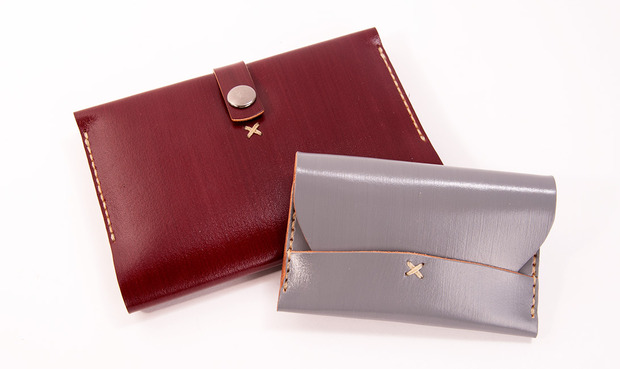
Many of us have experienced the rush of finding the perfect wallet—only to discover one feature that breaks the final decision, whether it’s an ostentatious logo or machine-stitched threading, promising to unravel. When a car designer decides to take matters into his own hands, however, and creates his dream wallet, the results are immaculate leather accessories that one rarely encounters in a retail environment.
JAQET (pronounced “jacket”), which launched last year, is the brainchild of LA-based Jacques Flynn, senior designer at Mazda, who applies his minimalist design philosophy for cars to create sleek, shiny wallets that hold just the essentials. Using full grain, vegetable tanned leather, the wallets are cut, hand-dyed and hand-stiched in Flynn’s apartment and garages. With the branding hidden inside, only the stitching and snaps are visible, letting the color be the focal point. Pouring thought and attention into an accessory that is used every day, and often thrown around without a second thought, Flynn has constructed a high-quality wallet that stands up to constant usage. Like a new baseball glove, he says, the stiff leather will only soften over time, flexing into a shape that suits you the most. We spoke with Flynn on designing cars, balancing two jobs and developing the newest JAQET color, Smoke.
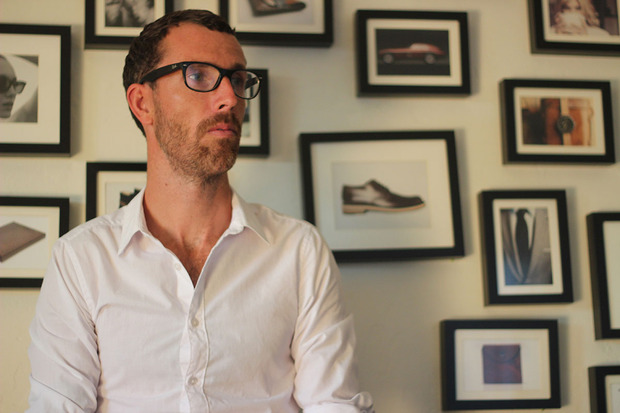
So tell us about your car design background.
I moved out here in 2000 to go to Art Center College of Design in Pasadena. I did some internships at BMW and Volkswagen. My pop is a pretty big car guy, so he got me into it early. I was the kid drawing cars in second grade; I’ve always fooled around drawing and liking cars.
I started at Mazda in 2006. The nice thing, I got kind of lucky—if you’re a car designer in America, you either live in LA or Detroit. So obviously, Detroit isn’t really the ideal situation, but it’s cool because you’re in the thick of it and you’re really in the front lines of the automotive industry. Here, a lot of the studios are called satellite studios. There are probably about ten to fifteen car companies that have studios out here, American, German, Japanese—basically if they sell cars in the market, they have satellite studios in LA.
What is the job market like for car designers?
The industry is so small these days that it’s pretty competitive. A lot of people go into product design, a lot of buddies design golf clubs. There are certain companies who seek out car designers and get them to do golf clubs or shoes. A lot of guys go to Portland, because Nike and Adidas are there, and they work for those guys. Everyone gets a pretty sweet gig. But the car design thing, it really depends on how the industry is doing. It’s such a volatile industry—when it’s good, it’s really good, and when it’s bad, no one’s hiring and people are let go.
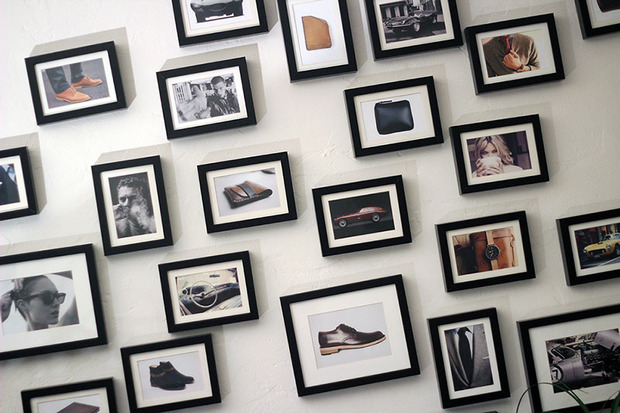
Out of curiosity, do you have many female colleagues?
One of my best friends was a lady and she works at Honda now. There’s definitely some ladies. In my studio, we have three departments. We have Exterior Design, which is what I fall under. We have Interior Design, then we’ve got a department called Color Materials. Those are generally made up of women and they’re very trend-focused and their job is to kind of look at upcoming trends and they develop colors and the materials for the car. If there’s anything that’s closely tied with fashion in the car world, it’s that department.
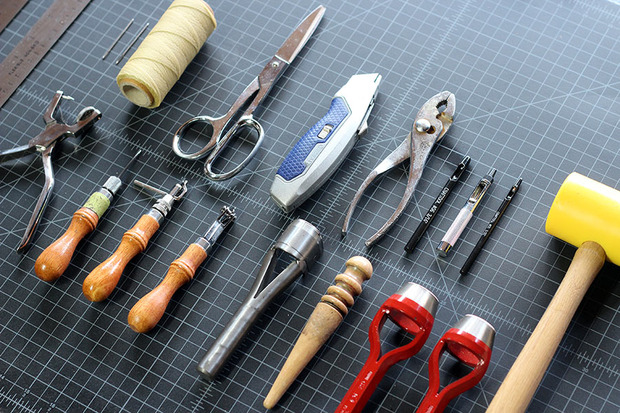
So how did you make the transition from designing cars to leather wallets?
That was kind of random. About three years ago, my wallet was on the fritz and I was like, “I need a new wallet. Let’s go out and get a new wallet.” And I knew what I wanted—which is basically what I’m designing with JAQET; a minimal, simple, really nice quality, a card holder. You’d find a couple from like Gucci and those guys, but they’re a little over-the-top. Some of them are made in Italy, but there’s a lot that are still made in China and I wasn’t really psyched on that.
I’m really into branding. I do that at Mazda actually, and I thought it would be fun to maybe start a little wallet company because I feel what I want isn’t out there. It started with me doing sketches—like how I approach car design; I just started doodling. I went into downtown LA to work with some guys and get samples done. They were really big on, “Yeah, yeah we’ll make a thousand of these.” Whereas I kind of just wanted to get something small going and was just looking for some guidance.
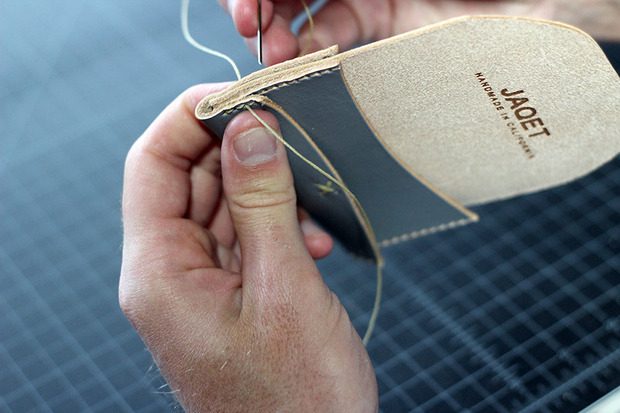
The samples they made, I actually wasn’t into because they use machines; they didn’t do a hand-stitch. So then I finally went and just bought some leather. I made a few that didn’t fall apart, then made them for some buddies to put them through the wash.
They turned out good, so then I was like, let’s do the branding part! The name, the logo, when I launched—it was a year ago. And I was like, “What do I want?” I don’t want to do just one wallet, and sell one wallet. I didn’t want it to feel too crafty. I wanted it to have a nice balance of—obviously there’s a craft and an element of handmade to it—but I wanted it to feel branded and you’re kind of buying into a brand as well as a nice piece of design and leather.
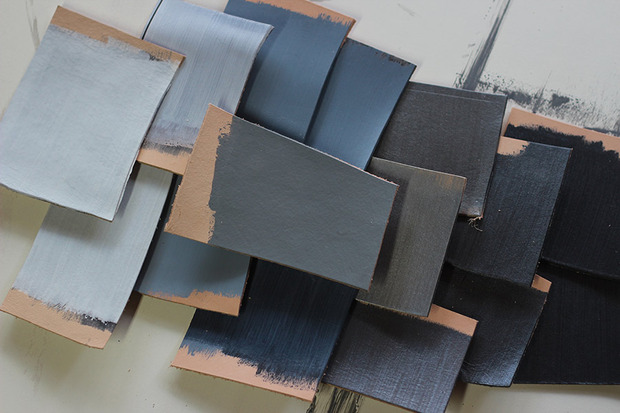
Do you feel that there are analogies between car and wallet design? Or is JAQET completely separate, and more of way for you take a break from your day job?
At the beginning it was. Now it’s gotten a little bit more insane. There’s definitely similarities in that, when I do a car and present a car (or the ideas) to my bosses, I always try and keep the message of the car very simple. No matter what car I’m doing, if it’s a sport car, a sedan or SUV, I always try to keep the design very minimal. And when I’m explaining the car, the message should be very simple.
When we design a car, there’s a whole lot of philosophical talk—how does the car fit into what’s going on right now, culturally, the whole bit. It’s crazy what conversations we have. And in the end, hopefully, we just get a cool-looking car. It was the same with JAQET when I was branding it and developing the product. When you look at it once, there’s enough consistency, there’s something either you like or don’t like, but you don’t have to dig deep to figure out what’s going on if that makes sense.
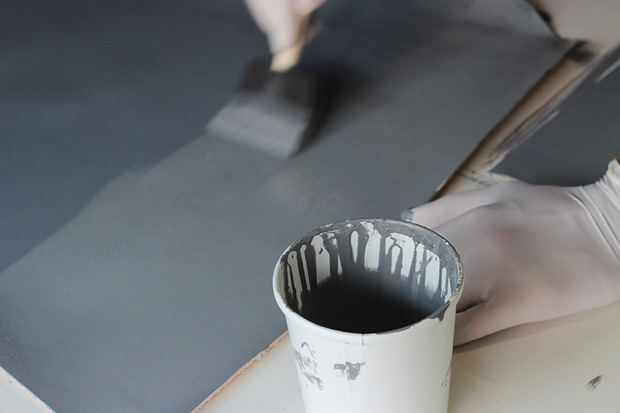
Is JAQET a spin-off of your own name?
I really love jackets. I have too many jackets. I get them all tailored and really well fit, and I thought, your wallet is sort of tailored and fit like one of these jackets. And the more you wear it, the more it becomes a part of your wardrobe. So I thought it would be fun to play off the article “jacket” but as well as my name.
The colors for your JAQET wallets are exclusive. How do you determine the colors?
I want it to feel not too artificial or synthetic. I want them to feel like they’ve got a tie to nature. I feel like you could find those colors back in cowboy days—they’re old school enough to where they work. I’m working on a gray right now—just a nice, flat gray. It’s really difficult though; I’ve got a couple different brands of dyes that I’m playing with.
It’s all done by hand. It’s a water-based dye, so it doesn’t soak in all the way through the leather. So it just sort of sits on top, which is nice because I don’t line any of the leather. So when you open your wallet, that’s the flesh side of the leather and you still see that and I brand the wallet inside on that. It’s got that nice, natural feeling.
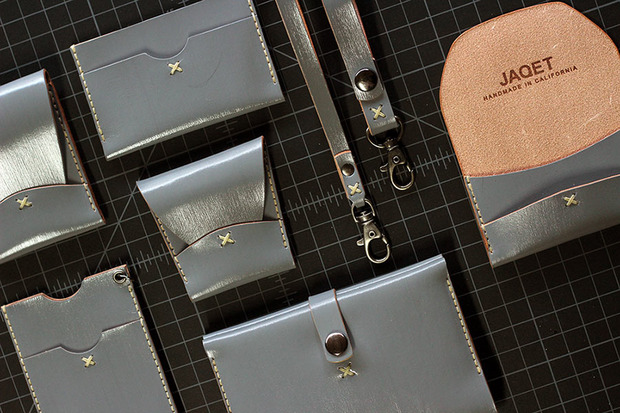
Can you describe how you make the wallets?
It’s all vegetable-tanned leather. So I buy hides that have been tanned with bark and natural stuff. It’s called tooling leather; it’s the color of a light wood. And that leather you can do all sorts of shit with—you can dye it, carve into it. People will carve entire scenes into these things, you can get pretty three-dimensional with it because some of the leathers are really thick; almost 3-4 millimeters thick.
And you make everything with your bare hands?
Yeah! Right now, I’m just out of my apartment and garages. I hired an assistant so we kind of crank on at night, when I get home from my real job. We just kind of go nuts. Sometimes on the weekends, but lately I’ve been trying to break on the weekends, just because I’m losing my mind there for a little bit.
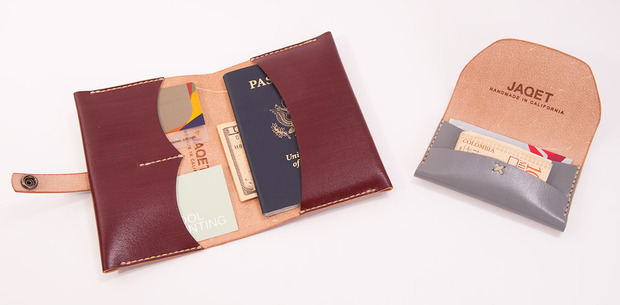
How do you balance both your day job and JAQET?
It’s not super-easy. I sell out of a lot of stuff. I know we can make more money if I hit it harder and reached out more. I mean, I love my day job—my day job is my dream job, so I’ve got no goal of quitting that. If this got to a point where it was just so big, I would maybe take a sabbatical or something [laughs]. We’re looking at new spaces and hiring more people, but I’ve sort of approached it like; just let it grow organically, produce what you can produce. I don’t make any commitments, really. I try and have fun with it. I’ve always called it my little project that people are into, but it’s not a full-fledged business yet, in my mind.
JAQET wallets range from $50 to $135 in various styles (we’re fans of the Passport wallet) and four different colors—and starting yesterday, a fifth: Smoke. For more information and to purchase products, visit the JAQET website.
Product photos by Nara Shin, all other images courtesy of Court Brewer









